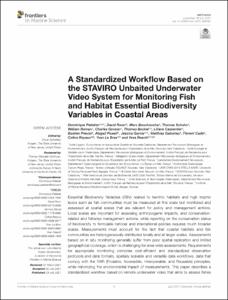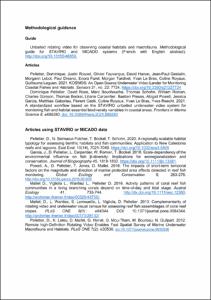| dc.contributor.author | Pelletier, Dominique | |
| dc.contributor.author | Roos, David | |
| dc.contributor.author | Bouchoucha, Marc | |
| dc.contributor.author | Schohn, Thomas | |
| dc.contributor.author | Roman, William | |
| dc.contributor.author | Gonson, Charles | |
| dc.contributor.author | Bockel, Thomas | |
| dc.contributor.author | Carpentier, Liliane | |
| dc.contributor.author | Preuss, Bastien | |
| dc.contributor.author | Powell, Abigail | |
| dc.contributor.author | Garcia, Jessica | |
| dc.contributor.author | Gaboriau, Matthias | |
| dc.contributor.author | Cade, Florent | |
| dc.contributor.author | Royaux, Coline | |
| dc.contributor.author | Le Bras, Yvan | |
| dc.contributor.author | Reecht, Yves | |
| dc.coverage.spatial | SW Pacific Ocean | en_US |
| dc.coverage.spatial | Mediterranean Sea | en_US |
| dc.coverage.spatial | Indian Ocean | en_US |
| dc.coverage.spatial | NE Atlantic Ocean | en_US |
| dc.date.accessioned | 2022-05-17T13:04:37Z | |
| dc.date.available | 2022-05-17T13:04:37Z | |
| dc.date.issued | 2021 | |
| dc.identifier.citation | Pelletier, D., Roos, D., Bouchoucha, M., Schohn, T., Roman, W., Gonson, C.,
Bockel, T., Carpentier, L., Preuss, B., Powell, A., Garcia, J., Gaboriau, M., Cadé, F.,
Royaux, C., Le Bras ,Y. and Reecht, Y. (2021) A Standardized Workflow Based on
the STAVIRO Unbaited Underwater Video System for Monitoring Fish and Habitat
Essential Biodiversity Variables in Coastal Areas. Frontiers in Marine Science, 8:689280, 17pp.
DOI: 10.3389/fmars.2021.689280 | en_US |
| dc.identifier.uri | https://repository.oceanbestpractices.org/handle/11329/1919 | |
| dc.description.abstract | Essential Biodiversity variables (EBV) related to benthic habitats and high trophic levels such as fish communities must be measured at fine scale but monitored and assessed at spatial scales that are relevant for policy and management actions. Local scales, such as individual marine parks, are important for assessing anthropogenic impacts, and conservation-related and fisheries management actions, while reporting on the conservation status of biodiversity to formulate national and international policies requires much broader scales. Measurements must account for the fact that coastal habitats and fish communities are heterogeneously distributed locally and at larger scales. Assessments based on in situ monitoring generally suffer from poor spatial replication and limited geographical coverage, which is challenging for area-wide assessments. Requirements for appropriate monitoring comprise cost-efficient and standardized observation protocols and data formats, spatially-scalable and versatile data workflows, data that comply with the FAIR (Findable, Accessible, Interoperable and Reusable) principles, while minimizing the environmental impact of measurements.
This paper describes a standardized workflow based on remote underwater video that aims to assess fishes (at species and community levels) and habitat-related EBVs in coastal areas. This panoramic unbaited video technique was developed in 2007 to survey both fishes and benthic habitats in a cost-efficient manner, and with minimal effect on biodiversity. It can be deployed in areas where low underwater visibility is not a permanent or major limitation. The technique was consolidated and standardized and has been successfully used in varied settings over the last twelve years. We operationalized the EBV workflow by documenting the field protocol, survey design, image post-processing, EBV production and data curation. Applications of the workflow are illustrated here based on some 4500 observations (fishes and benthic habitats) in the Pacific, Indian and Atlantic Oceans, and Mediterranean Sea. The STAVIRO’s proven track-record of utility and cost-effectiveness indicates that it should be considered by other researchers for future applications. | en_US |
| dc.language.iso | en | en_US |
| dc.rights | Attribution-NonCommercial-ShareAlike 4.0 International | * |
| dc.rights.uri | http://creativecommons.org/licenses/by-nc-sa/4.0/ | * |
| dc.subject.other | STAVIRO (STAtion VIdeo ROtative) | en_US |
| dc.title | A standardized workflow based on the STAVIRO unbaited underwater video system for monitoring fish and habitat essential biodiversity variables in coastal areas. | en_US |
| dc.type | Journal Contribution | en_US |
| dc.contributor.corpauthor | Institut Français de Recherche pour l’Exploitation de la Mer (IFREMER) | en_US |
| dc.description.notes | This paper was published as part of a Frontier Research Topic "Marine Biodiversity Observation Network".
see doi: 10.3389/fmars.2021.832328 | en_US |
| dc.description.refereed | Refereed | en_US |
| dc.format.pagerange | 17pp | en_US |
| dc.identifier.doi | 10.3389/fmars.2021.689280 | |
| dc.subject.parameterDiscipline | Fisheries and aquaculture | en_US |
| dc.subject.parameterDiscipline | Macroalgae and seagrass | en_US |
| dc.subject.parameterDiscipline | Rock and sediment biota | en_US |
| dc.subject.parameterDiscipline | Underwater photography | en_US |
| dc.subject.parameterDiscipline | Biota abundance, biomass and diversity | en_US |
| dc.subject.parameterDiscipline | Birds, mammals and reptiles | en_US |
| dc.subject.parameterDiscipline | Human activity | en_US |
| dc.subject.instrumentType | underwater cameras | en_US |
| dc.subject.dmProcesses | Data acquisition | en_US |
| dc.subject.dmProcesses | Data analysis | en_US |
| dc.subject.dmProcesses | Data format development | en_US |
| dc.subject.dmProcesses | Data visualization | en_US |
| dc.subject.dmProcesses | Data archival/stewardship/curation | en_US |
| dc.bibliographicCitation.title | Frontiers in Marine Science | en_US |
| dc.bibliographicCitation.volume | 8 | en_US |
| dc.bibliographicCitation.issue | Article 689280 | en_US |
| dc.description.sdg | 14.a | en_US |
| dc.description.eov | Fish abundance and distribution | en_US |
| dc.description.eov | Hard coral cover and composition | en_US |
| dc.description.eov | Sea grass cover and composition | en_US |
| dc.description.eov | Macroalgal canopy cover and composition | en_US |
| dc.description.eov | Marine turtles, birds, mammals abundance and composition | en_US |
| dc.description.maturitylevel | Mature | en_US |
| dc.description.adoption | Multi-organisational | en_US |
| dc.description.ebv | Taxonomic diversity | en_US |
| dc.description.ebv | Species distribution | en_US |
| dc.description.ebv | Population abundance | en_US |
| dc.description.ebv | Population structure by size class | en_US |
| dc.description.ebv | Phenology | en_US |
| dc.description.ebv | Habitat structure | en_US |
| dc.description.ebv | Ecosystem extent and fragmentation | en_US |
| dc.description.ebv | Ecosystem composition and functional type | en_US |
| dc.description.ecv | Marine habitats | en_US |
| dc.description.supportingotherVariables | Seabed cover and morphology | en_US |
| dc.description.sensors | Underwater video lander | en_US |
| dc.description.methodologyType | Method | en_US |
| obps.endorsementAuthorDeclared.goodPractice | Conservatoire des Espaces Naturels de Nouvelle-Calédonie | |
| obps.endorsementAuthorDeclared.goodPractice | South Province of New Caledonia | |
| obps.endorsementAuthorDeclared.goodPractice | North Province of New Caledonia | |
| obps.endorsementAuthorDeclared.goodPractice | Loyalty Province of New Caledonia | |
| obps.endorsementAuthorDeclared.goodPractice | Côte Bleue Marine Park | |
| obps.endorsementAuthorDeclared.goodPractice | Cerbère-Banyuls Natural Marine Reserve | |
| obps.endorsementAuthorDeclared.goodPractice | Reunion Island Natural Marine Reserve | |
| obps.endorsementAuthorDeclared.bestPractice | Coral Sea Marine Park | |
| obps.endorsementAuthorDeclared.bestPractice | Mayotte Natural Marine Park | |
| obps.contact.contactname | Dominique Pelletier | |
| obps.contact.contactemail | dominique.pelletier@ifremer.fr | |
| obps.contact.contactorcid | 0000-0003-2420-1942 | |
| obps.resourceurl.publisher | https://www.frontiersin.org/articles/10.3389/fmars.2021.689280 | |
 Repository of community practices in Ocean Research, Applications and Data/Information Management
Repository of community practices in Ocean Research, Applications and Data/Information Management


